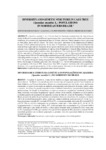Please use this identifier to cite or link to this item:
http://www.alice.cnptia.embrapa.br/alice/handle/doc/162699Full metadata record
| DC Field | Value | Language |
|---|---|---|
| dc.contributor.author | SILVA, E. F. da | pt_BR |
| dc.contributor.author | MARTINS, L. S. S. | pt_BR |
| dc.contributor.author | OLIVEIRA, V. R. de | pt_BR |
| dc.date.accessioned | 2011-04-10T11:11:11Z | pt_BR |
| dc.date.available | 2011-04-10T11:11:11Z | pt_BR |
| dc.date.created | 2009-07-22 | pt_BR |
| dc.date.issued | 2009 | pt_BR |
| dc.identifier.citation | Revista Brasileira de Fruticultura, v. 31, n. 1, p. 174-181, mar. 2009. | pt_BR |
| dc.identifier.uri | http://www.alice.cnptia.embrapa.br/alice/handle/doc/162699 | pt_BR |
| dc.description | Spondias mombinL. is a fruit tree from the American continent from the Anacardiaceae family. In Brazil it is common in different vegetation types but is more frequent in the Atlantic and Amazonian rainforests. It is economically important because of its fruits, which are widely consumed raw or processed as fruit jellies, juices and ice creams. The leaves have great importance in the pharmaceutical industry because of their antibacterial properties. In the state of Pernambuco, cajá tree is widely distributed in the Zona da Mata region and less frequently in the Agreste and Sertão areas. In this work diversity and genetic structure were studied in four populations of cajá tree from Pernambuco?s Zona da Mata, Northeast Brazil, using isozymes polymorphism analyses from electrophoreses. The result showed 100% of polymorphism (P) for nine alleles (A)and the average of alleles per locus s was 2.4. The expected heterozygosity (He) ranged from 0.530 to 0.574 and the observed heterozygosity (Ho), from 0.572 to 0.735. It was not observedin breeding and the average FIT was -0.175, whereas within population inbreeding (f) varied from -0.08 to - 0.37. The genetic divergence among the populations (FST) ranged from 0.006 to 0.028 and the average was 0.026. The average of estimated gene flow (Nm) was high (5.27). The CG-IPA population, corresponding to the germplasm collection of IPA, showed more than 96% of genetic similarity with other populations; therefore, it is a good representative of the existent genetic diversity in the Zona da Mata region. | pt_BR |
| dc.language.iso | eng | eng |
| dc.rights | openAccess | eng |
| dc.subject | Cajazeira | pt_BR |
| dc.subject | Isoenzimas | pt_BR |
| dc.subject | Conservação de germoplasma | pt_BR |
| dc.subject | Diversidade genética | pt_BR |
| dc.subject | Spondias mombin L | pt_BR |
| dc.subject | Genetic diversity | pt_BR |
| dc.title | Diversity and genetic struture in cajá tree (Spondias mombin L.) populations in Northeastern Brazil. | pt_BR |
| dc.type | Artigo de periódico | pt_BR |
| dc.date.updated | 2016-06-02T11:11:11Z | pt_BR |
| dc.subject.thesagro | Genética vegetal | pt_BR |
| dc.subject.thesagro | Germoplasma | pt_BR |
| dc.subject.thesagro | Caja | pt_BR |
| dc.subject.nalthesaurus | Spondias | pt_BR |
| dc.subject.nalthesaurus | Germplasm conservation | pt_BR |
| dc.subject.nalthesaurus | Isozymes | pt_BR |
| riaa.ainfo.id | 162699 | pt_BR |
| riaa.ainfo.lastupdate | 2016-06-02 | pt_BR |
| dc.contributor.institution | EDSON FERREIRA DA SILVA, UNIVERSIDADE FEDERAL RURAL DE PERNAMBUCO | pt_BR |
| dc.contributor.institution | LUIZA SUELY SEMEN MARTINS, UNIVERSIDADE FEDERAL RURAL DE PERNAMBUCO | eng |
| dc.contributor.institution | VISELDO RIBEIRO DE OLIVEIRA, CPATSA. | eng |
| Appears in Collections: | Artigo em periódico indexado (CPATSA)  | |
Files in This Item:
| File | Description | Size | Format | |
|---|---|---|---|---|
| OPB2386.pdf | 81,59 kB | Adobe PDF |  View/Open |









